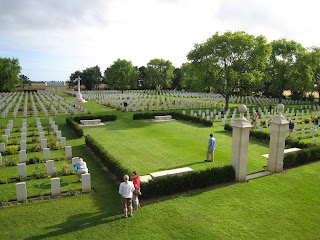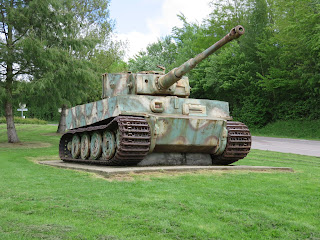From Dieppe we took the road for the Normandy battlefields. Our first stop, on the way in to Caen, was the Abbaye Ardenne. This medieval abbey was the headquarters of Kurt Meyer's 25th SS Panzergrenadier Regiment of the 12th SS Hitler Youth Division. On the night of 7-8 June 1944, troops under Meyer's command interrogated and then murdered 18 Canadian prisoners of war in the abbey garden. Two more were murdered in similar fashion later in the month. This was just one site among a number in Normandy where similar war crimes were committed by the SS.
The following day, we hit the D-Day beaches. We began at Beny-sur-Mer Canadian War Cemetery. Most of the burials are for the casualties of the fighting in the early stages of the Battle of Normandy.
This group shot was taken right outside the cemetery.

Next stop was Juno Beach, and the town of Bernieres-sur-Mer. The Queen's Own Rifles assaulted this beach, assisted by tanks from the Fort Garry Horse. The large house on the beach is visible in many period photos taken during the assault.

After Bernieres, we headed for the Juno Beach Centre, in Courseulles-sur-Mer. Courseulles was taken by the Royal Winnipeg Rifles and the Regina Rifles. It was the toughest of the Canadian targets on D-Day owing to the number of German strongpoints on this sector of the beach. This photo shows a 25-pounder, the primary field gun in the British and Canadian armies.
This bunker at Courseulles was taken by the Royal Winnipeg Rifles.
The plaque reads: "'Cosy's Bunker.' This bunker was stormed and taken by Lt. W.F. (Cosy) Aitken and 10 Platoon of 'B' Company, The Royal Winnipeg Rifles, on 6 June 1944. 'B' Company suffered 78% casualties assaulting 'Mike Green' Beach."
Churchill tank on Juno Beach at Courseulles.
Remains of the Mulberry harbour are visible in the English Channel at Arromanches on Gold Beach. The Dieppe raid taught the Allies how difficult it would be to capture a defended port, and port facilities were crucial to the logistical build-up that would accompany the invasion. So, the Allies simply towed their own pre-fab harbours across the Channel and assembled them off the beaches! The American harbour off Omaha Beach succumbed to the great storm that hit the area beginning on 17 June, but remnants of the British harbour survive to this day.
Our last stop of the day was at the American cemetery at Omaha Beach. The mood and the message is quite different here than it is at the Commonwealth War Graves Commission cemeteries. For me, the large monuments and ringing bells suggest almost a Disneyfication of remembrance. "Our" cemeteries seem (to me) much more reserved, thoughtful, and touching.
Omaha Beach. German bunker visible at centre.

The next day we explored the battlefields south of Caen in the rain, so the next few photos are from the 2014 tour, which was graced with better weather! This is the Canadian memorial at Point 67, taken by the Calgary Highlanders during Operation Atlantic. This position overlooks the towns of St-Andre-sur-Orne and St-Martin-de-Fontenay, with Verrieres Ridge in the distance.
A better look at Verrieres Ridge and St-Martin, from where the Black Watch made their disastrous assault on the ridge during Operation Spring, 25 July 1944. The ridge was not taken until 7-8 August, during Operation Totalize.
Bretteville-sur-Laize Canadian War Cemetery is the resting place of those casualties who fell during the latter stages of the Battle of Normandy.
We stopped in Falaise for a very rainy lunch break. Last year it was much sunnier!
Here is William the Conqueror's statue and his castle, with the hotel de ville in between.
After lunch we looked at the closing of the Falaise gap. This field of poppies overlooks the gap near St-Lambert-sur-Dives.

Major David Currie of the South Alberta Regiment won the Victoria Cross at St-Lambert-sur-Dives, for holding the town amidst determined counterattacks from German troops trying to escape the Falaise pocket.

This is the Polish memorial at Mont Ormel, which overlooks the Germans' escape route out of the the pocket.
This Tiger tank outside Vimoutiers broke down and was abandoned by its crew during the final stages of the battle to close the Falaise gap.












































